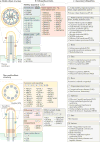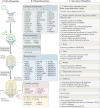Genes and molecular pathways underpinning ciliopathies
- PMID: 28698599
- PMCID: PMC5851292
- DOI: 10.1038/nrm.2017.60
Genes and molecular pathways underpinning ciliopathies
Abstract
Motile and non-motile (primary) cilia are nearly ubiquitous cellular organelles. The dysfunction of cilia causes diseases known as ciliopathies. The number of reported ciliopathies (currently 35) is increasing, as is the number of established (187) and candidate (241) ciliopathy-associated genes. The characterization of ciliopathy-associated proteins and phenotypes has improved our knowledge of ciliary functions. In particular, investigating ciliopathies has helped us to understand the molecular mechanisms by which the cilium-associated basal body functions in early ciliogenesis, as well as how the transition zone functions in ciliary gating, and how intraflagellar transport enables cargo trafficking and signalling. Both basic biological and clinical studies are uncovering novel ciliopathies and the ciliary proteins involved. The assignment of these proteins to different ciliary structures, processes and ciliopathy subclasses (first order and second order) provides insights into how this versatile organelle is built, compartmentalized and functions in diverse ways that are essential for human health.
Figures





References
-
- Fisch C, Dupuis-Williams P. Ultrastructure of cilia and flagella back to the future! Biol Cell. 2011;103:249–270. - PubMed
Publication types
MeSH terms
Substances
Grants and funding
LinkOut - more resources
Full Text Sources
Other Literature Sources
Molecular Biology Databases

